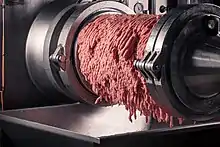Mechanically separated meat
Mechanically separated meat (MSM), mechanically recovered/reclaimed meat (MRM), or mechanically deboned meat (MDM) is a paste-like meat product produced by forcing pureed or ground beef, pork, mutton, turkey or chicken, under high pressure through a sieve or similar device to separate the bone from the edible meat tissue. It is sometimes called white slime as an analog to meat-additive pink slime and to meat extracted by advanced meat recovery systems, both of which are different processes. The process entails pureeing or grinding the carcass left after the manual removal of meat from the bones and then forcing the slurry through a sieve under pressure. This puree includes bone, bone marrow, skin, nerves, blood vessels, and the scraps of meat remaining on the bones. The resulting product is a blend primarily consisting of tissues not generally considered meat along with a much smaller amount of actual meat (muscle tissue). In some countries such as the United States, these non-meat materials are processed separately for human and non-human uses and consumption.[1] The process is controversial; Forbes, for example, called it a "not-so-appetizing meat production process".[2]



Mechanically separated meat has been used in certain meat and meat products, such as hot dogs and bologna sausage,[2] since the late 1960s. However, not all such meat products are manufactured using an MSM process.
History
The practice of mechanically compiling leftover meat scraps dates to the 1950s when hand tools were developed to help remove the remaining pieces of meat and fascia from animal carcasses to minimize waste. Primarily MSM was developed and produced in countries whose agriculture was human conducted and because of it likely were unable to provide mass quantities of regularly processed meat for widespread and affordable consumption. By the 1960s, machines changed from manual operation to automatic operation. This change allowed meat company owners to use meat scraps and sell them to people for a price lower than the price of normal cut meat. During the 1970s these techniques became more common in other parts of the world as well. In addition to poultry slaughterhouses being new to the market, other newcomers recognized the financial gains mechanically separated meat processing provided. Eastern European countries, especially, are known for their import of frozen chicken MSM.
In the 1950s mechanically separated meat was mostly used as a raw material for the production of hot dogs. Currently, luncheon meats, burgers, and mortadella are regularly made from MSM.
Safety and regulation
Questions arose in the 1980s as to the safety of mechanically separated meat. In 1982, a report published by U.S. Food Safety and Inspection Service (FSIS) on mechanically separated meat said it was safe and established a standard of identity for the food product. Some restrictions were made on how much can be used and the type of products in which it can be used. These restrictions were based on concerns for limiting intake of certain components in mechanically separated meat, such as calcium.[3] Mechanically separated meat may not be described simply as "meat" on food labels, but must be labeled as "mechanically separated" pork, chicken, or turkey in the ingredients statement. Hot dogs can contain no more than 20% mechanically separated pork.
Concerns were raised again when the bovine spongiform encephalopathy (BSE) epidemic, commonly known as "mad cow disease", occurred in the United Kingdom in 1986. Since bits of the spinal cord (the part most likely to be carrying the BSE prion)[4][5] often got mixed in with the rest of the meat, products using mechanically separated meat taken from the carcasses of bovines were at higher risk for transmitting BSE to humans. As a result, in 1989, the United Kingdom tightened restrictions to help ensure pieces of the spinal cord would not be present in mechanically separated meat taken from bovines.[6] In the mid-1990s, the UK government banned MRM from cattle backbone, in 1998 MRM from any ruminant backbone and in August 2001 from any ruminant bone. In 2001, the government prohibited the sale of MRM beef for human consumption to prevent the spread of bovine spongiform encephalopathy.[7]
Similar United States Department of Agriculture (USDA) rules became effective November 4, 1996, and were later updated, stressing:
Due to FSIS regulations enacted in 2004 to protect consumers against bovine spongiform encephalopathy, mechanically separated beef is considered inedible and is prohibited for use as human food. It is not permitted in hot dogs or any other processed product.[8]
See also
- Specified risk material (SRM)
- Advanced meat recovery (AMR)
- Meat slurry
- Pink slime
- Potted meat food product
- Mad cow disease
- Lena Groeger: science journalist who compared meat textures generated by different mechanical procedures
References
- Lena Groeger (April 12, 2012). "And You Thought It Was Just 'Pink' Slime". ProPublica.
- Micky Meece (April 12, 2012). "Take a Look at 'White Slime, ' a 'Pink Slime' Cousin". Forbes. Retrieved 2012-04-17.
- "Health and Food Safety | European Commission". Retrieved 2015-06-27.
- "Bovine Spongiform Encephalopathy". USDA. March 2005. Archived from the original on 2011-11-13. Retrieved 2011-11-20.
- "FSIS Further Strengthens Protections Against Bovine Spongiform Encephalopathy (BSE)". USDA. March 2005. Archived from the original on 2012-03-21. Retrieved 2011-11-20.
- "What is mechanically recovered meat". BBC News. August 9, 2001. Retrieved 2011-11-20.
- "Meat and Poultry Labeling Terms".
- "Hot Dogs and Food Safety". USDA. August 6, 2013. Retrieved 2014-06-17.